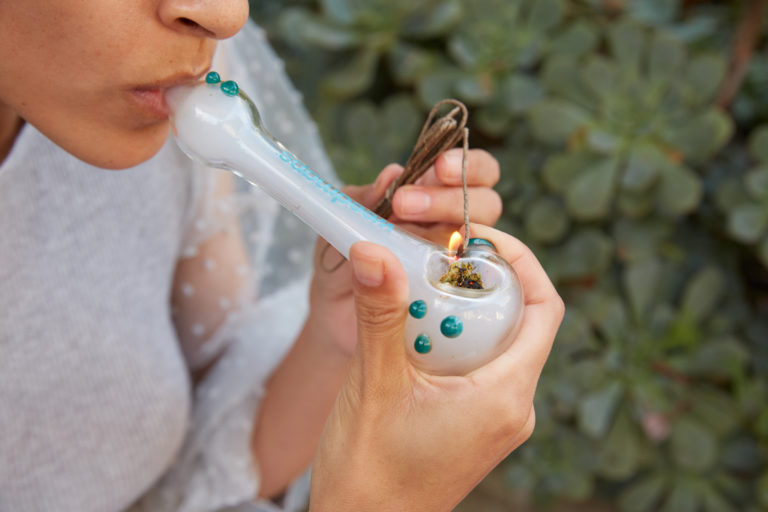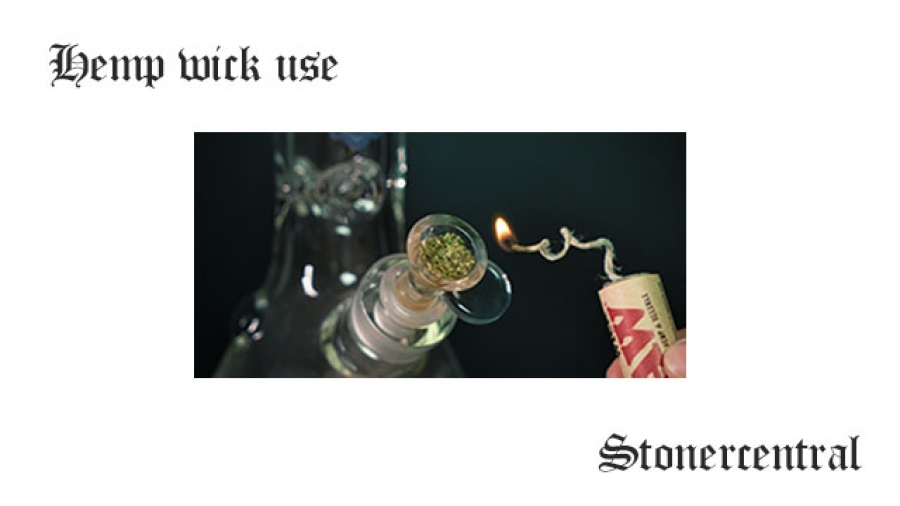While it might look like the stuff you made hippie necklaces out of in high school, hemp wick is definitely for smoking.
Marketed as a natural alternative to lighters and matches, this weed accessory has been popping up in head shops and cannabis stores all over Canada. But is it a better way to burn?
What is Hemp Wick?
Hemp wick is essentially a length of hemp twine that’s been coated in beeswax. Think of it as a slow-burning candlewick, especially for use with pipes and bongs.
Simply light it up with a match or lighter, use it to spark your bowl as needed, then blow or shake it out when done. Be careful, of course, not to burn yourself. Because it’s a little bit sticky, you can even keep it wrapped and ready around your lighter or bowl.
Why Use It?
The theory is inhaling hot butane from a lighter or the admixture of combustible chemicals, glue and wood from a match is worse for your body than a flame atop all-natural, wax-coated hemp twine. Hemp is cannabis, after all—it’s the same plant you’re already smoking (although, as you know, there’s really nothing in it that’s going to get you high).
Hemp wick also burns at a lower temperature than a lighter, meaning that hits are smoother and there’s more potential to appreciate terpenes. Added bonus: with hemp wick, very little ends up having to go to landfill.
How Is Hemp Wick Sold?
You can buy a tiny bundle for just a dollar or two to rolls of up to 420 feet (no joke) or more. It can come in different diameters too–the thicker the twine, the slower and larger the flame–though it’s mostly sold at 1.0 millimetres. If your local head shop or cannabis store doesn’t have it, it’s very easy to find online—even the Ontario Cannabis Store carries it. Various hemp wick dispensers are also available.
Why should you use hemp wick?
When you use a butane lighter to light up your cannabis, butane gas causes the flame to burn at a very high temperature. When you inhale, the smoke is much hotter, burns off more cannabinoids and terpenes, and carries the butane with it into your lungs. When you use matches, too, you inhale a mixture of glue, wood, and combustible chemicals that’s much more than a clean flame. While butane lighters and matches are more convenient ways to light your bong, some would rather keep their lungs clear of harmful materials.
Raw hemp wick coated in beeswax offers a slow burn from all-natural materials, which many users say produces a cleaner cannabis flavor than a lighter or match. Some tokers also prefer using hemp wicks to light up their weed because it makes the process more straightforward. The flame on a strand of raw hemp wick won’t go out, the point is more precise, and it’s easy to hold your bud up to a slow-burning piece of twine.
Using hemp wick produces a more flavorful hit. It may even maximize your bud’s potency because the low-temperature flame doesn’t burn off the same amount of terpenes and cannabinoids as non-natural fire sources. This is one of the same reasons many joint tokers like using hemp paper as their rolling paper of choice. Hemp rolling papers produce a cleaner, more even smoking experience that doesn’t carry the same carcinogens or chemicals as other rolling papers.
How to use hemp wick
First, unfurl your roll of hemp wick and peel away the tape that keeps it together so that one end of the twine is sticking out and ready to use. Some hemp rolls come in lengths up to 800 feet, so make sure not to unravel it entirely, or you’ll have a mess on your hands. Hemp wick is also a bit sticky due to the beeswax, so try to store it in a clean space where it won’t accumulate too much dust or debris. Many tokers will keep a long piece of raw hemp wick around their lighter or bowl for easy access.
Hold the freed strand away from any wind or fabrics and light the tip of your hemp wick using a lighter or a match. Yes, we did explain why it’s not ideal to use butane lighters, but don’t worry. The first light of the butane-gas fire is to get the burn started, and the portion of hemp wick that touches the butane will burn away immediately, leaving your raw hemp wick chemical-free.
Allow the flame to burn for a little bit to keep it going correctly and remove any trace of chemicals. Once you have a gentle, even flame, use it as you would any source to spark up your cannabis.
For a joint, use the raw hemp wick to light the twisted end of the rolling paper and inhale, the same way you would use a lighter or match. Hemp wicks maintain their shape when you hold them up, rather than flop down like other twines or string.

To light a pipe or bong, place the tip of the hemp wick into the bowl and inhale. If desired, you can leave the hemp wick lighter in the bowl while inhaling to maintain a smooth, even burn.
When you’re done using your hemp wick, extinguish it by dipping the tip in water or pressing the fire out with wetted fingertips. Let it cool down and then wrap it back up for safe, effective storage. Make sure that the tip is extinguished before wrapping it into the hemp bundle – otherwise, you risk burning your entire supply.
Hemp wick takes a few extra steps but is well worth the effort to enjoy a smooth, flavorful cannabis smoke.
What is the best hemp wick?
It’s hard to go wrong when choosing a hemp wick product, but many cannabis dispensaries will have various hemp wick and hemp paper brands available for the health-conscious consumer. Some are simply industrial hemp fibers dipped in beeswax, while others use hemp grown explicitly to make hemp lighters. These specialty varieties often feature intricate weaving and high-grade beeswax, usually with a subtle floral aroma.
What else is hemp wick used for?
Hemp wick’s usefulness extends far beyond cannabis smoking. Thanks to its beeswax layer, hemp wick can be used in candle-making as well as for lighting candles, stoves, and campfires.
It’s also a popular choice in the crafts world, where individuals prize its organic look, vibrant brown coloring, and long-lasting durability. Crafters use hemp to string jewelry, bind scrapbooks, make macrame crafts, and in packaging or gift-wrapping. Gardeners also use hemp wick to tie plants to support stakes.

I love hempwick, but for reasons I never hear from others: it keeps the flame away from your fingers! I have a few bowls that are deep; toking alone or with the boyfriend, I never need to fill the bowl up – the hempwick allows me to focus the flame right down where I need it.